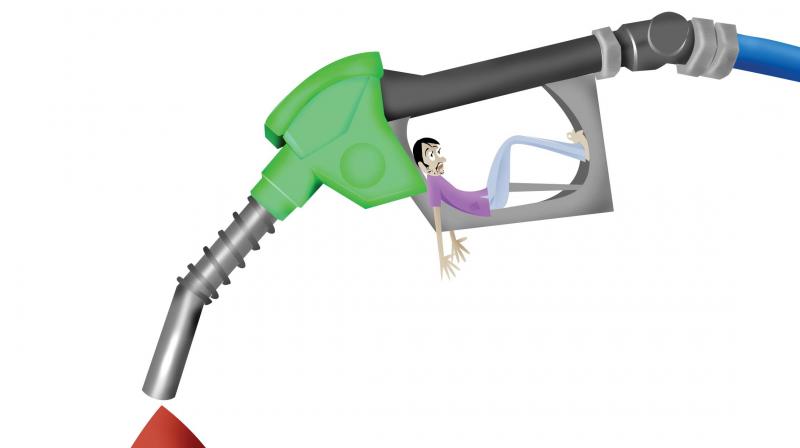Namma Chennai diary: The middle class is India's whipping boy
The daily dynamic pricing may have hidden the daily increments of a few paise.

The days are gone when you went whistling while riding into the petrol pump. As the international fuel prices were in free fall in 2014 from a high of Rs 6,330 per barrel on May 26, 2014 the day that Narendra Modi took over as Prime Minister, the government was passing on the benefits to the consumer. The prices were such that they left a good deal of money in the purses of the people, which they could spend on other things, essentials as well as luxuries. The government caught on quickly and began raising the central excise on the petrol rate at the pump from December 2014 so that all the fall in international prices was mopped up as revenue.
The increase in the price of petrol and diesel at the pump since the daily dyna mic pricing mechanism was introduced on June 16 has been steep, but the international prices have gone up by about 13 per cent from $47.86 on July 1 to $53.06 on September 13 and rising slightly since then thanks to Hurricane Harvey hitting Houston and interfering with the production process there. However, all arguments on the retail price of petrol and diesel are defeated when you consider that the Indian pump price is about 60 per cent higher than in any of the nearest subcontinental countries like Pakistan, Bangladesh, Sri Lanka and Nepal.
The public angst at rising prices is justifiable. The daily dynamic pricing may have hidden the daily increments of a few paise, but after being spread over three months, their effect became obvious to the consumer and was also reflected in the wholesale inflation figures going up. Where the current calculations behind the pricing at the pump appears are distorted is in comparison to four years ago when the international crude oil prices were at an astronomical high of $108 per barrel and the rupee was around 62 to the US dollar. Today, the price of a barrel of oil is still under $54 (and the dollar is around Rs 64.50), which means half the rate it was selling at four years ago. Greedy governments have been hitting every user of fuel by mopping up more and more revenue through VAT, which is as high as 46.52% on petrol in BJP-ruled Maharashtra, above 38% in Andhra and Madhya Pradesh, 34% in Kerala and 27% in Delhi.
Every family in India is a consumer of fossil fuels, either directly or indirectly and the impact of fuel prices is inescapable in a developing economy. Subsidies that existed in the extreme case of diesel till some years ago tended to distort market conditions and they have been given up. The clamour for the government to absorb some of the rise in market prices is not misplaced and it can do so by cutting the excise or VAT component. But no! The finance minister says he needs all the money for infra spending. Aren’t they building highways, he asks. Yes, they are, but what is there for the ordinary consumer of petrol apart from potholed roads in the cities and speed breakers, which claim lives every day of two-wheeler riders?
To the middle class, the taxes must seem a huge burden because they are the ones who get the least of the subsidies but pay most of the taxes. To them, any finance minister must appear sadistic and the current one more so because he bluntly refuses to even countenance saying a few words in sympathy for those who are paying almost half the price of a litre of fuel in taxes, either to the states or the Centre. What they get in return from these is a pittance – not good roads, not good drains and no safe way of negotiating the city traffic. Does it matter to the common man if the government has raised the spending on infra or if the GDP growth is being impelled now only by public spending and FDI?
The people must pay is a proposition that most finance ministers swear by. In the absence of big collection in the revenue basket, they are forced to fleece those who don’t complain too much. Even if they do, the common people are a hapless lot as they have to carry the can for all the rich men who forgot to pay their taxes. Fuel is an ingenious way to hit everyone as – by one account – 4.159 million barrels a day (of petrol, diesel and kerosene) were consumed by the country per day in 2015. Let’s assume in 2017 we consume 4.165 million barrels per day, multiply that by159 litres, which is what one US barrel contains, while the UK barrel contains a little over 163 litres.
A consumption of 4.165 million barrels of fuel per day translates to 662.2 million litres per day or, as we say, 66.22 crore litres per day. In refining, a litre of oil should roughly give 0.5 litre of petrol, 0.3 litre of diesel and the rest in various byproducts like jet fuel, kerosene, etc. Let’s assume then that 53 crore litres of petrol and diesel are consumed every day. Since each litre can be taken to yield at least Rs 25 (At a very conservative estimate) in taxes to the Centre and the State, we arrive at a very rough estimate of a whopping tax collection per day of Rs 1,590 crores per day, which is very close to a tax yield Rs 40,000 crore a month from just petrol and diesel.
Is there something wrong with my figures. I stand corrected on this if I am wrong, but will the government ever release figures like these. They wouldn’t want you to know that Rs 40,000 crore a month is being taken from fuel a month as tax, right? Go figure what you get in return for Rs 40,000 crore save highways for which you pay toll to use anyway. Suffice it to say we middle class are the whipping boys of this country.

